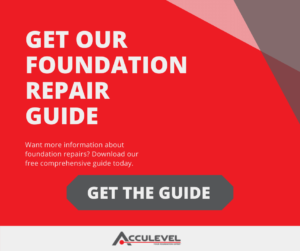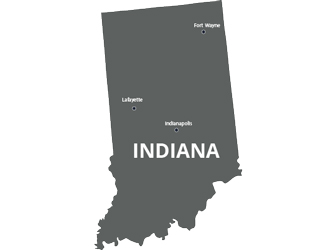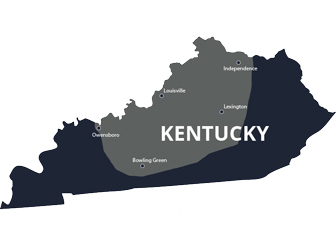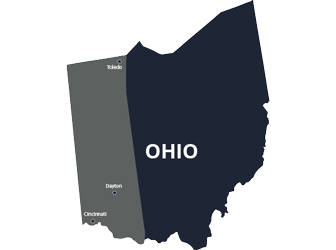No one wants to find foundation damage in their basement or crawl space. Not ever. Whether you see cracks, water intrusion, or worse, these are all problems that will cost money to fix.
The important thing is that you have the problems solved promptly and correctly. Delaying repairs means the issues become more severe, and the costs more expensive.
Acculevel is a family-owned and operated repair company that focuses on foundation repair and waterproofing. We have multiple products and repair methods that are ideal for concrete/cinder block foundations. Since our start in 1996, we’ve helped more than 35,000 homeowners restore strength and stability to their homes.
In this article, we’re going to review the most common problems that develop in a block foundation. We’ll illustrate the types of cracks you’ll see, and explain what repair methods work best in given situations.
Water is the Cause, Even if You Don’t See It
The first sign you have a problem? Is usually a crack in the wall. These cracks may not let in water right away, but they will eventually. We can say that with confidence, because the number one cause of foundation cracks is hydrostatic pressure.
Hydrostatic pressure occurs when there is more water in the ground than it can absorb. The excess water spreads out, because there’s nothing in its path to stop it- until it runs into your foundation. Gradually, this water accumulates until it is applying pressure against the wall.
Because concrete is a porous material, the water will eventually seep in. But you may not see it in your basement. Concrete blocks have hollow cores, so when water seeps through the exterior side of the block, it can collect in this open center. It may fill up the hollow core of the wall for several blocks before it starts seeping through the interior side. So whatever water you see in your basement, you can be sure there is more in your wall.
How To Resolve Water Intrusion in a Block Foundation
If you have water in your basement, you’ll need to deal with that in addition to repairing the cracks. If you don’t, you can expect to have more water and cracks developing later. It may not be in the same place- or on the same wall- but it will happen. Hydrostatic pressure can’t be stopped, because there’s no way to prevent it from raining.
There are a couple different kinds of water drainage that can be used, depending on the type of foundation and floor you have in your home. If you have a crawl space, the “floor” is probably the ground below your home. That’s going to require geochannel drainage, which is designed to filter out the dirt and debris typical of a crawl space.
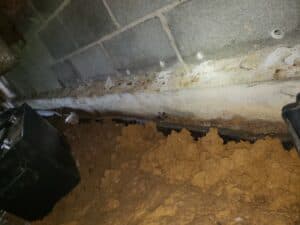
This photo was taken by an Acculevel crew member, after installing water drainage in a customer’s home. You can see the geochannel is installed along the footer.
If you have a basement, the best option will be either water tunnel or fast track drainage. The choice between the two depends on the thickness of your basement floor and the stability of your foundation’s footer. You can learn more about these options in this article, which explains the circumstances for each drainage type.
There is one service that you will need, that is specific to block foundation walls, and that is weep holes.
What Are Weep Holes?
Weep holes are holes that are literally drilled into the bottom row of concrete blocks of your foundation. If you look at the picture we used to illustrate geochannel, you’ll see small holes in the blocks above the footer.
You need weep holes in block foundations to release the water that collects inside the blocks.

Illustration made by the author.
You don’t want the water in the block’s core to stay there. If it’s in there long enough, it can stagnate, or cause mold to grow. (Or both.) It can also cause the block to crack and further decay.
Now, letting the water out through weep holes will just release into your basement- unless you direct it. This is why water drainage in a block foundation also uses dimple board. This isn’t a piece of lumber- it’s a type of plastic liner that catches the water and directs it down into the water drainage channel.
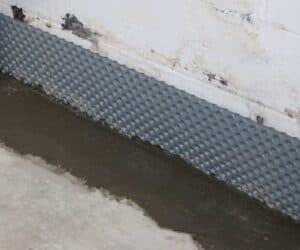 This photo was also taken by an Acculevel crew member after water drainage installation. The weep holes are covered by the dimple board.
This photo was also taken by an Acculevel crew member after water drainage installation. The weep holes are covered by the dimple board.
Why Don’t You Need Dimple Board in a Crawl Space?
In a crawl space, there’s no poured concrete floor. The installation crew only needs to dig a trench around the perimeter of the crawl space to hold the drainage. The drainage is installed next to the footer, but isn’t covered up by concrete. (We place pea gravel in the trench to hold the geochannel in place, then backfill with the dirt that was removed.)
In a basement, we break up the perimeter of the basement so we can access the footer. Drainage is installed on top of -or next to- the footer, depending on its condition. Once the drainage is held in place (also with pea gravel), dimple board is attached to the walls. The dimple board covers the weep holes and extends down to the footer.
Once everything is in place, we can pour new concrete over the drainage to restore the basement floor. Since the dimple board creates slight channels from the weep holes down below the floor, the draining water doesn’t intrude out onto your basement floor.
How Do You Repair Cracks in a Block Foundation Wall?
Once you’ve stopped the water from causing future damage to your block foundation, it’s time to repair the cracks you currently have. The best repair method will depend on the severity of the cracks, and whether or not the wall is actively bowing (leaning) inward.
Cracks can form in two different shapes: long horizontal cracks, and zig-zag (also called stairstep) cracks. You may only have one kind, or both.
 This photo was taken by an Acculevel project advisor during an in-home assessment. The basement wall in this home had both kinds of cracks.
This photo was taken by an Acculevel project advisor during an in-home assessment. The basement wall in this home had both kinds of cracks.
Minor Cracks With Little to No Water Intrusion
Minor cracks can be repaired using an epoxy fill. In our experience, epoxy is the best method available. Over the last 25+ years, we’ve tried multiple formulas and methods, but the others didn’t meet our (admittedly) high standards. Epoxy fill has a slight flexibility to it, which allows it to move as the concrete expands/contracts with the seasons. But it also has the durability to hold up for years at a time. We warranty crack repairs for 5 years.
Cracks and Slightly Bowing Walls
If the wall is not yet bowing inward, or is leaning less than 2 inches into the basement, carbon fiber straps are the best and least expensive repair method. These are made of kevlar-grade carbon fibers, and we warranty these repairs for the life of your structure. We register our warranties for the home’s address, not the homeowner’s name. This means whenever you sell your home, the warranty is 100% transferable at no cost to you or the buyer.
Please understand that there are a variety of carbon fiber straps on the market, and some contractors use weaker or less effective kinds. Acculeve will only install straps manufactured by Fortress Stabilization Systems; these are the strongest and most durable available.
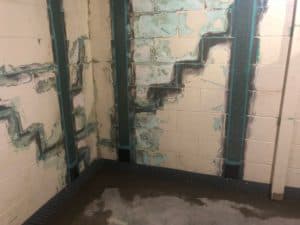 This photo was taken by an Acculevel crew member, after repairing cracks and installing both carbon fiber straps and water drainage.
This photo was taken by an Acculevel crew member, after repairing cracks and installing both carbon fiber straps and water drainage.
In addition to being the most effective repair method, carbon fiber straps are also the easiest to install. The installation is done entirely from the inside of your home, no excavation needed.
The straps are also easy to manage after they have cured (epoxy has completely dried). You can paint over the repaired section with a regular wall paint to match the other walls.
Please note: all of the repair methods we’re reviewing (carbon fiber straps, wall anchors, and helical tiebacks) are focused on stabilizing your foundation. If you want the wall straightened, that is an additional service we can provide.
More Substantial Cracks or Bowing Require More Intrusive Repairs
If your basement wall is bowing more than 2 inches, you will need either wall anchors or helical tiebacks. Both of these are effective repair methods, but anchors require excavation and tiebacks do not.
How Do Wall Anchors Work?
To install wall anchors, you need to dig a hole in the yard and bury a steel place to function as the anchor. A similar steel plate is attached inside the basement, and a steel shaft is driven through both plates and tightened until the bowing wall is stabilized. The excavation for the anchor is usually 10 feet away from the foundation, and this is where your property’s limitations come into the equation.
If you have a large feature or appliance in the way, like an inground pool or a septic system? Or if the property line itself is less than 10 feet from your damaged wall? Wall anchors are not a good fit for you.
 This is an illustration of wall anchors.
This is an illustration of wall anchors.
How Do Helical Tiebacks Work?
Helical tiebacks don’t require excavation; like carbon fiber straps, they’re installed from inside your basement. However, you still have to be mindful of what is outside that wall.
A steel shaft with screw-like (helical) blades on the end is drilled through the wall and into the ground outside. Because these can be angled deeper into the ground, they can often be used where anchors cannot.
 This is an illustration of a helical tieback installation
This is an illustration of a helical tieback installation
Both wall anchors and helical tiebacks are also warrantied for the life of your structure.
Do You Have More Questions About Foundation Repairs?
If you would like to know more about foundation repairs, hydrostatic pressure, or pricing on any of the repair types, please check out our complete guide. This thorough review of the topic and its FAQs is available for free and is designed to be a resource for all homeowners.
If you need an expert to review your home, and determine what repairs are needed to restore your home to its full potential, call Acculevel at 866-669-3349. We will schedule an appointment for you with one of our project advisors, and they will come to your home, discuss your concerns, and help you develop a whole-home solution to keep your greatest investment secure for the future. Don’t like to talk on the phone? Fill out the online form, instead! Our awesome customer service representatives can email or text with you, to get your appointment set-up.
Don’t live in Indiana, or the surrounding areas? You can still check out our Foundation Repair Guide, and use our checklist of questions to ask a contractor. This is another free resource, and it will help you evaluate potential repair companies to find the one that is right for you.




